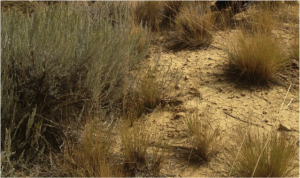 LAND COVER • Land cover refers to that which is covering the ground at any given location, and is not to be confused with land use, or how a landcover functions from an anthropocentric point of view. Land cover is a landscape attribute that plays a major role in supporting all levels of the food chain, adding organic matter to soil, decreasing erosion, improving soil water retention, sequestering carbon, and guiding human livelihoods, among others. UHPSI has devoted considerable time to analyzing and developing maps of ranch-wide land cover, as well as to evaluating the accuracy of those maps. Read more…>>
LAND COVER • Land cover refers to that which is covering the ground at any given location, and is not to be confused with land use, or how a landcover functions from an anthropocentric point of view. Land cover is a landscape attribute that plays a major role in supporting all levels of the food chain, adding organic matter to soil, decreasing erosion, improving soil water retention, sequestering carbon, and guiding human livelihoods, among others. UHPSI has devoted considerable time to analyzing and developing maps of ranch-wide land cover, as well as to evaluating the accuracy of those maps. Read more…>>
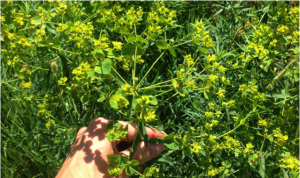 INVASIVE SPECIES • Invasive species are flora and fauna that are not endemic to a given area, and for which there are often poor biological mechanisms to control their spread and influence. Such species are commonly characterized by aggressive behavior, often flourishing under conditions where native flora and fauna do not, in turn displacing native varieties. On the Ucross Ranch, it is impossible to monitor all locations for damage or infestation from invasive species. This is why UHPSI uses a combination of field research and satellite imagery analysis to address the spread of invasives such as leafy spurge. Read more…>>
INVASIVE SPECIES • Invasive species are flora and fauna that are not endemic to a given area, and for which there are often poor biological mechanisms to control their spread and influence. Such species are commonly characterized by aggressive behavior, often flourishing under conditions where native flora and fauna do not, in turn displacing native varieties. On the Ucross Ranch, it is impossible to monitor all locations for damage or infestation from invasive species. This is why UHPSI uses a combination of field research and satellite imagery analysis to address the spread of invasives such as leafy spurge. Read more…>>
 HYDROLOGY • The Ucross Ranch sits atop ancient geologic structures which are constantly altered through the power of water. With loose, exposed, mineral soil dotting the landscape, the Ranch is subject to potentially high levels of erosion in the uplands, reduced ground-water retention, and significant changes in creek and river channel structure. The UHPSI team has a strong interest in evaluating the degree to which changes in land cover and land use affect the hydrologic regime across the Ranch. This topic is addressed through multifaceted GIS modelling, and geo-spatial time-series analysis using historic photographs. Read more…>>
HYDROLOGY • The Ucross Ranch sits atop ancient geologic structures which are constantly altered through the power of water. With loose, exposed, mineral soil dotting the landscape, the Ranch is subject to potentially high levels of erosion in the uplands, reduced ground-water retention, and significant changes in creek and river channel structure. The UHPSI team has a strong interest in evaluating the degree to which changes in land cover and land use affect the hydrologic regime across the Ranch. This topic is addressed through multifaceted GIS modelling, and geo-spatial time-series analysis using historic photographs. Read more…>>
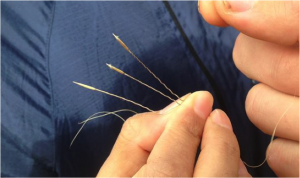 RANGELAND HEALTH • Ucross is a work working cattle and sheep ranch, where the livestock depend on the landscape and the local ranchers depend on the livestock. The UHPSI team will soon begin a comprehensive, ranch-wide research program to systematically evaluate the landscape using statistically sound sampling strategies. The intent would be to capture a “snap-shot” of rangeland health such that future studies could better evaluate more subtle changes in the landscape. This research will give us a picture of grass distribution, abundance of exposed soil, nutrient composition of plant matter, and more. Read more…>>
RANGELAND HEALTH • Ucross is a work working cattle and sheep ranch, where the livestock depend on the landscape and the local ranchers depend on the livestock. The UHPSI team will soon begin a comprehensive, ranch-wide research program to systematically evaluate the landscape using statistically sound sampling strategies. The intent would be to capture a “snap-shot” of rangeland health such that future studies could better evaluate more subtle changes in the landscape. This research will give us a picture of grass distribution, abundance of exposed soil, nutrient composition of plant matter, and more. Read more…>>
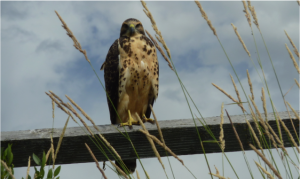 AVES • Much of the Ucross Ranch is open rangeland with little more than grasses and sagebrush. While this terrain might appear devoid of animal life, the Ranch harbors a wealth of bird species. In our avian research program, we are using custom-built acoustic monitoring units to record ambient noise at certain locations at certain times of day and night. UHPSI researchers are then extracting bird calls and songs from the sound files, and converting the records of bird presence and absence into geographic datasets. In time, we will develop species distribution maps and phenological templates for the more vocal species on the Ranch. Read more…>>
AVES • Much of the Ucross Ranch is open rangeland with little more than grasses and sagebrush. While this terrain might appear devoid of animal life, the Ranch harbors a wealth of bird species. In our avian research program, we are using custom-built acoustic monitoring units to record ambient noise at certain locations at certain times of day and night. UHPSI researchers are then extracting bird calls and songs from the sound files, and converting the records of bird presence and absence into geographic datasets. In time, we will develop species distribution maps and phenological templates for the more vocal species on the Ranch. Read more…>>
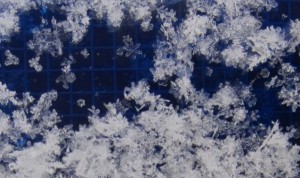 SNOW • The Ucross ranch falls within the larger Powder River Basin, a hydrological drainage area that relies heavily on snow melt from the Bighorn Mountains to the West. Each year, snow accumulation and its relative water content changes, contributing different amounts of water to the drainage during the warmer months. As global climatic conditions become more variable, snow and ice qualities become increasingly important to monitor for efficient use of water resources by those who depend on them most. In this way, studies of winter snowpack will serve the farmers and ranchers who depend on it most. Read more…>>
SNOW • The Ucross ranch falls within the larger Powder River Basin, a hydrological drainage area that relies heavily on snow melt from the Bighorn Mountains to the West. Each year, snow accumulation and its relative water content changes, contributing different amounts of water to the drainage during the warmer months. As global climatic conditions become more variable, snow and ice qualities become increasingly important to monitor for efficient use of water resources by those who depend on them most. In this way, studies of winter snowpack will serve the farmers and ranchers who depend on it most. Read more…>>
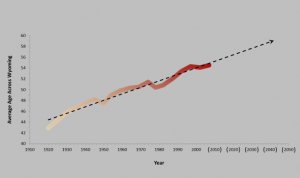 DEMOGRAPHICS • The United States has a long history of agriculture, but starting with the industrial revolution citizens have moved off the land and toward the cities. Over time, a connection to the land has diminished, leaving the older agriculturalists to support our farming and ranching heritage. The story in Wyoming is no different — fewer and fewer young adults are following in their parent’s and grandparent’s footsteps. Where UHPSI seeks to improve the “triple bottom-line”, understanding the social history and trends of the High Plains is essential in addressing management concerns of the present and future. Read more…>>
DEMOGRAPHICS • The United States has a long history of agriculture, but starting with the industrial revolution citizens have moved off the land and toward the cities. Over time, a connection to the land has diminished, leaving the older agriculturalists to support our farming and ranching heritage. The story in Wyoming is no different — fewer and fewer young adults are following in their parent’s and grandparent’s footsteps. Where UHPSI seeks to improve the “triple bottom-line”, understanding the social history and trends of the High Plains is essential in addressing management concerns of the present and future. Read more…>>

